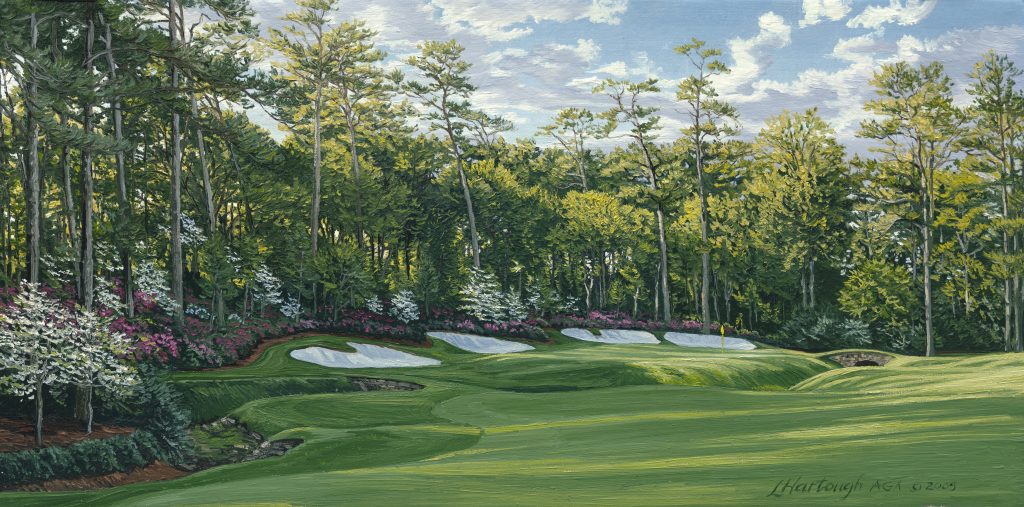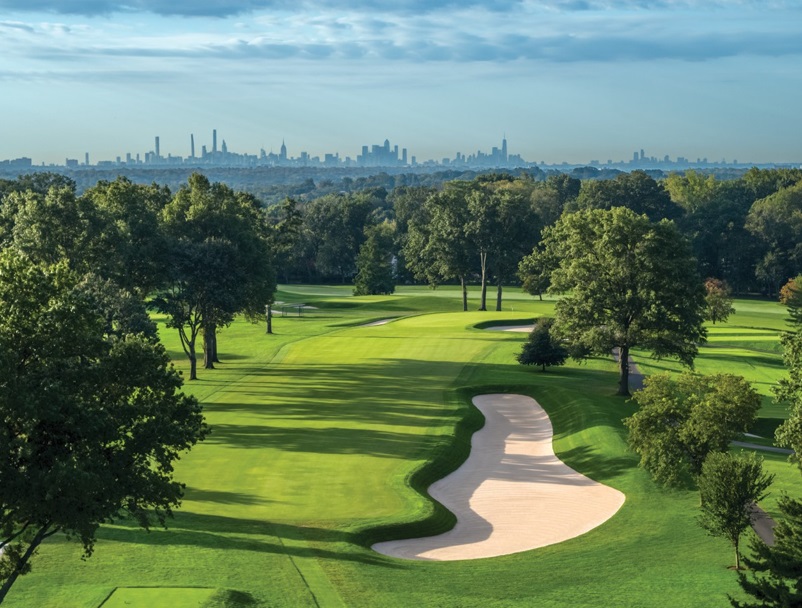Art depicting private clubs has for decades been woven into the fabric of the club world. Many private clubs, including many National Club Association (NCA) members, have commissioned accomplished painters and photographers to memorialize their clubhouses, facilities and most storied holes. Others have turned to photographers who specialize in club photography to shoot their clubs. The resulting artwork can be found in clubhouse foyers and boardrooms as well as members’ homes. Photographs and paintings of the most famous clubs are also often purchased by fans of the game who cherish time spent there or by those who just love the courses.
Golf and club art is so popular that a vibrant industry has grown around it. Artists devote entire careers to producing it and clubs seek out those artists to produce one-of- a-kind artwork for their facilities. There’s even an Academy of Golf Art (academyofgolfart.org), which was created to promote awareness and appreciation for golf art as fine art. The Academy is an educational body that uses art to promote the game of golf, its environs, participants, and traditions, and it sponsors artistic demonstrations and artistic competitions.

Fairways & Greens Presented in Oil
One of the most prominent members of the Academy of Golf Art is Linda Hartough, a founding trustee and well- known painter who has devoted her career to painting the world’s most iconic golf courses. After beginning her career as a traditional landscape painter, she focused her skills on
creating oil paintings of some of the world’s greatest courses. She is the only artist ever commissioned by the United States Golf Association and the Royal and Ancient Golf Club of St. Andrews to create the annual paintings and prints for the U.S. Open and British Open Championships. Her paintings are in the collections of such famous clubs as Augusta National and Pine Valley, as well as the private collections of Jack Nicklaus, Robert Trent Jones and Rees Jones.
“I’ve been painting all my life,” said Hartough. “I got my start in golf art in 1984 when Augusta National commissioned me to paint the wonderful 13th hole, which became the first commissioned painting that Augusta National ever sold prints of. Soon thereafter I was also commissioned by The Country Club in Brookline, Mass., and by 1988, I was painting nothing but golf.” Painting for a club, or painting one of its landmark holes, is paintings measuring 40 by 60 inches are common. One of her paintings that hangs in Augusta National is an impressive 33 x 78.
“They take so much work that I can only do two or three paintings a year,” said Hartough. “A large painting can take up to six months to complete. And that doesn’t include the prep work, which includes taking photographs at different times of day, in different light, and at different times of the year. I do so much prep work that by the time I start, I know exactly what I’m going to paint.”
Hartough doesn’t attend major tournaments anymore. She says tournament weeks are long and require her to spend all day every day at the course. Still, she had a lot of fun selling her prints at these tournaments and getting to know the people who play in them, run them and cover them for the media. Today, she’s content to take on private commissions from both individuals and clubs, all of which keeps her busy.
“Many clubs display the originals I paint,” said Hartough. “And they want prints of my paintings to sell to members and friends of the club.”
The Fun of It
As you’d expect of someone who has an enormous undertaking. Hartough’s paintings are very large—painted the world’s most famous golf holes, Hartough has had her share of fun and interesting adventures.
“My first time at St. Andrews was in 1988,” she said. “I had an agent who was a member of the club, and I had a really good chance to explore the course and the town for a week. When my agent came back to pick me up, he got me into the R&A for a midnight tour!
“My project with Pine Valley was a thrill too,” she continued. “Ernie Ransome, who had commissioned the painting, escorted me into the club to show me where the painting was going to be hung.” Many of the clubs for which she paints allow her to sell prints of her work; her website (hartough.com) shows many of the other paintings she has done through the year.
Iconic Course Through a Camera Lens
Golf course photography is also extremely popular among clubs and golf fans. One of the best-known golf course photographers, Evan Schiller, is typically booked six months in advance.
Schiller has been a golf course photographer for a quarter century, but he didn’t begin his career as an artist. Before ever picking up the camera, he was a club professional in New York. He also played on professional tours, including the European tour and several mini tours, including the Nike and Web.com tours.
His photography career began after he finished playing in the California Open in Palm Springs.
“After we finished playing the tournament, someone mentioned a new course down the street that turned out to be the Stadium Course at PGA West,” said Schiller. “I went and played it and remember coming down the 9th hole to discover this beautiful scene in front of us with Pete Dye’s railroad ties and the reflection in the water. I decided then and there to run and get a camera.”

And a career was born.
“It took a while to get established as a golf course photographer,” said Schiller. “When I worked at clubs, I really enjoyed teaching, so I kept working as a teaching pro in those early days.”
“When I started, there weren’t a ton of golf course photographers,” he continued. “No one was really doing it, so I had
to figure it out on my own. I didn’t take photography lessons; I just learned how to do it. In the early years, I shot with film, which is very sensitive to x-ray, so I when I flew I had to carry everything in lead bags. I also had to bring rolls and rolls of film. Today I shoot with digital cameras, which is much better. I can do a lot more with my equipment and there’s much less that can go wrong.”
Today, he is one of the best-known golf course photographers in the world and clubs come to him directly. Courses hire him to shoot their properties and typically use those photographs to showcase their clubs on social media or via websites and advertising programs.
A typical assignment takes Schiller anywhere from a few days to a week to complete. He doesn’t schedule more than one project in a week because there’s no way of knowing if the weather will cooperate. Schiller uses a Fuji camera as well as a DJI Inspire 2 drone to photograph and video the golf course(s). After the shoot is done he needs a couple of days to edit his shots.
Of course, it’s not always a simple matter of scheduling a few days at a course to take photos. He needs to plan around each club’s maintenance, tournaments and league schedules. And for clubs that host professional tournaments, he needs to be careful his schedule doesn’t conflict.
“One of the challenges of going out in the morning to shoot is that maintenance crews are out there doing their work,” said
Schiller. “Tracks and footprints in morning dew will ruin a shot, and I can’t take photos of holes when staff are mowing or doing other maintenance. A lot of my prep work involves coordinating with course superintendents.”
The Stories
“One of my favorite stories happened about 20 years ago when I was shooting Old Head in Ireland,” said Schiller. “It’s a spectacular course that sits out on a promontory jutting into the Atlantic, and I was invited to take a helicopter up to capture some aerial shots. My wife was working as my assistant that day and I had taught her how to empty and reload the three cameras I brought so I wouldn’t have to stop to reload. With the film I was using, you only have 10 or 12 frames from a full roll, so she was very busy. They take the doors off and strap you in so there’s nothing in the way, and the pilot gave us a preflight speech warning us not to let anything fall out of the copter because if it hit the rotor, we were going down. Each roll of film came wrapped in its own foil packaging, and she had to rip the foil and take out the film. As she did, she was shoving the packages way down into her pockets. I didn’t realize it, but she soon ran out of room in her pockets and couldn’t figure out what to do with all the foil that was quickly accumulating. So, she started eating it, deciding that was better than losing the foil and bringing the copter down!”
“Another fun day happened on a photography trip in the Dominican Republic. I was shooting Corrales, a Tom Fazio resort in Punta Cana, and was invited to play. On one hole, I shot my drive way, way right, onto another fairway. I hit my ball back towards the green and as my caddie and I were driving back to our hole, we saw another cart coming our way. My caddie knew the guy who was driving the cart and excitedly started yelling ‘Misha!’ It turned out to be Mikhail
Baryshnikov and he played the last three holes with us. At one point, my wife hit a shot and the club flew out of her hands and almost hit him. She was mortified, but he whispered, ‘What happens in Punta Cana stays in Punta Cana.’ When we finished golfing, he came back to our host’s house with us for a glass of wine and a lot of laughs.”
These kinds of experiences make all the travel worth it. Schiller says that over the past few years, he has traveled about 100,000 miles. You can see some of his work at evanschillerphotography.com.
Celebrating Clubs
Club art is really about celebrating clubs and what makes each one special. Great artists like Linda Hartough and Evan Schiller don’t merely create pictures of clubs and courses. They demonstrate what’s truly special about those clubs, and the game of golf itself. That’s why more clubs than ever are turning to Hartough and Schiller and their peers in the golf art world to create works of art for their properties and their members.
Bill Smith is president of Smith Phillips Strategic Communications. He can be reached at bsmith@smith-phillips.com.


